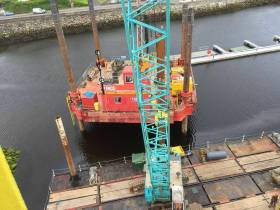Displaying items by tag: Killybegs Fishery Harbour Centre
Marine Notice: Dredging and Quay Construction Works at Killybegs Fishery Harbour Centre
The Department of Transport has been advised that the Marine Engineering Division of the Department of Agriculture, Food and the Marine is undertaking dredging and quay construction works at Smooth Point in Killybegs Fishery Harbour Centre, Co Donegal.
As previously reported on Afloat.ie, the contract for the completion of works at Smooth Point was awarded in July to Sorensen Civil Engineering Ltd.
Works were set to begin last month and will continue until April 2023, subject to weather and operational constraints.
Plant on site includes a backhoe dredger, modular pontoon dredgers, split hopper barges, tugs and other smaller vessels.
For safety reasons mariners are requested to stay clear of the dredging zone for the duration of the works in the harbour and are requested to proceed with caution in the area of the new pier. Wave wash from vessels should be avoided.
A map of the dredging area as well as contact information can be found in Marine Notice No 77 of 2022, attached below.
Work Underway On Small Craft Harbour at Killybegs
#KillybegsProject - A marine piling project is underway in Killybegs, Co Donegal on phase 3 of the small craft harbour.
The contract to ABCO Marine at the Killybegs Fishery Harbour Centre that began late last month, is on behalf of the Department of Agriculture, Food and the Marine (DAFM).
The works will include the provision and installation of stell tubular piles and floating breakwater pontoons, associated connections and ancillaries. Additional works are also required to integrate phase 3 installation with the previous phase 1 and 2 pontoon arrangements.
ABCO's marine plant involves the C57 Red Squirrel jack-up barge, a transfer barge, support work boats to support the piling operations.
The works according to ABCO are progressing to programme, with the piling to be completed this month, in advance of the new floating pontoon installation.





























































